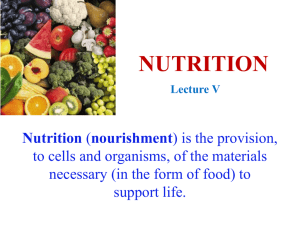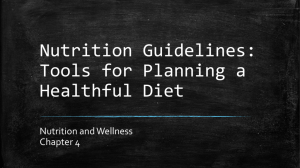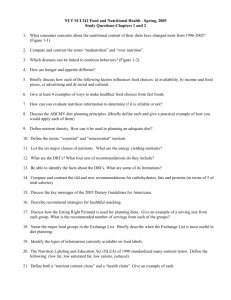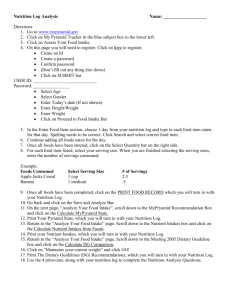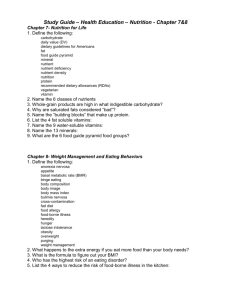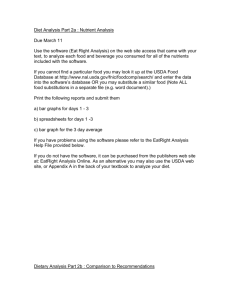幻灯片 1
advertisement
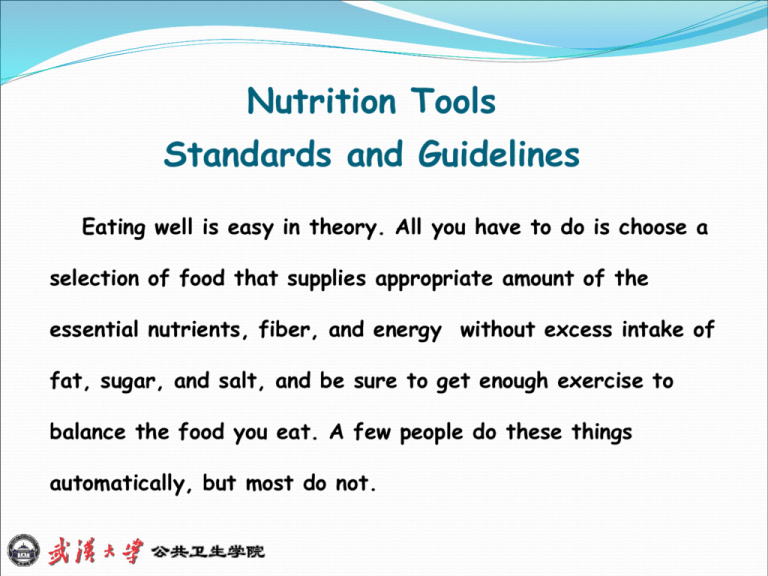
Nutrition Tools Standards and Guidelines Eating well is easy in theory. All you have to do is choose a selection of food that supplies appropriate amount of the essential nutrients, fiber, and energy without excess intake of fat, sugar, and salt, and be sure to get enough exercise to balance the food you eat. A few people do these things automatically, but most do not. Nutrient recommendations Nutrient recommendations are sets of yardsticks used as standards for measuring healthy people’s energy and nutrient intakes. For 50 years, the Recommended Dietary Allowances (RDA) have been the U.S. nutrient intake standards; in Canada their equivalents were the Recommended Nutrient Intakes (RNI) for Canadians .Today, both of these standards are being replaced by the Dietary Reference Intakes (DRI). Recommended Dietary Allowances (RDA) Formerly, the name of the nutrient intake standards of the United States. Currently, the RDA constitute a part of the Dietary Reference Intakes (DRI). RDA are average daily amounts of nutrients considered adequate to meet the known nutrients needs of practically all healthy people. Dietary Reference Intakes A set of nutrient intake values for the dietary nutrient intakes of healthy people in the United States and Canada. These values are used for planning and assessing diets and include these four lists of values: 1. Estimated Average Requirement (EAR) Population-wide average nutrient requirements used in nutrition research and policy-making. The basis upon which RDA values are set. 2.Recommended Dietary Allowances (RDA) Nutrient intake goals for individuals. Derived from the Estimate Average Requirements (see below). 3.Adequate Intakes (AI) Nutrient intake goals for individuals. Set whenever scientific data are insufficient to allow establishment of an RDA value. 4.Tolerable Upper Intake Levels (UL) Suggested upper limits of intake for potential toxic nutrients. Intake above the UL are likely to cause illness from toxicity. Daily Value (DV) Nutrient standards used on food labels, in grocery stores, and on some restaurant menus. The DV allow comparisons among foods with regard to their nutrient content. Why do we need new standards ? 1: setting intake Recommendations for individuals One of the great advantages of the DRI values recommended intakes lies in their applicability to individuals. In the past, nutrient standards were appropriate for planning and assessing the diets of populations; their developers discouraged their use for individuals. In contrast, individuals are prime concern of the DRI committee. 2:Preventing Chronic Diseases Another advantages of the DRI is that they set the recommended intakes to take into account disease prevention, where appropriate ,as well as nutrient adequacy. In the last decade , abundant new research has linked nutrients in the diet with the promotion of health and the prevention of chronic diseases, and the DRI committee used this research to advantage. 3: Facilitating nutrition research and policy Another set of values established by the DRI committee accomplishes other important tasks. This set ,the Estimated Average Requirements (EAR), establishes population-wide average requirements that researchers and nutrition policymaker use in their work. Nutrition scientists may use the ERA as standards in research. Public health officials may also use them to assess nutrient intakes of populations and make recommendations. 4: Establishing safety guidelines A final goal of the DRI committee is to establish upper limits of intake for nutrients that can pose a hazard when they are overconsumed. These value ,the Tolerable Upper Intake Limits (UL) ,are indispensable to consumers who take supplements or eat foods to which vitamins or minerals are added. Dietary Guidelines why do we need “guidelines”?“ Nutrient intake recommendations do much to ensure nutrient adequacy, they do little for moderation. Nutrient recommendations address intakes of protein, vitamins, and mineral, they also make some general statements about energy intakes, but they do little to protect people from excess intake of fat, sugar, salt, and other food constituents believed to be related to chronic diseases. Guidelines take up where nutrient recommendations leave off, and they go a step further in recommending physical activity to improve or maintain body weight. The DRI refer to nutrients, not foods. Guidelines specify healthful uses of foods and nutrients because many people need guidance in selecting the foods they consume each day. Guidelines may be to revise Linking Nutrients, Foods, and Health Adequacy Balance Calorie Control Moderation Variety How the experts make a judgement for food nutrition value The Dietary Guidelines for Americans Eat a variety of foods. Balance the food you eat with physical activity—maintain or improve your weight. Choose a diet with plenty of grain products ,vegetables, and fruit. Choose a diet moderate in sugars. Choose a diet moderate in salt and sodium. If you drink alcoholic beverages, do so in moderate Dietary Guidelines for Americans (2000) Aim for Fitness Aim for a healthy weight Be physically active each day Build a Healthy Base Let the Pyramid guide your food choices Choose a variety of grains daily Choose a variety of fruits and vegetables daily Keep food safe to eat Choose Sensibly Choose a diet that is low in saturated fat and cholesterol, and moderate in total fat Choose beverages and foods to moderate your intake of sugars Choose and prepare foods with less salt If you drink alcoholic beverages, do so in moderation China Food Guide (pagoda) 5.油脂类25克 4.奶类及奶制品100克 豆类及豆制品50克 3.畜禽肉类50~100克 鱼虾50克、蛋类25~50克 2.蔬菜类400~500克、 水果类100~200克 1.谷类300~500克 Britain Food Guide Mediterranean Pyramid Compared Dietary guideline allow you to choose foods that you enjoy. Notice that these guidelines do not require that you give up your favorite foods or eat strange, unappealing foods .Almost anyone’s diet adjustments ,can fit most of these recommendations . The secret for most people seems to be to modify the diet in four ways. First, learn to watch portion sizes, especially of fat-rich foods such as high-fat meats, dairy products, and desserts. Second, strictly limit a few foods, especially pure fats and sugar, such as margarine and sugary soft drinks. Third, make substitutions, such as fat-free or low-fat for high-fat dairy products. Finally, eat more whole grains, fruits, and vegetables. Our watchword is reasonable nutrition and balanced diet How much activity do you need? Research on health and physical activity leads to a single conclusion: people need exercise as well as nutrition to stay and live long. Many groups make recommendations about how much physical activity is enough, but answer for any one people depends on personal goals. Diet Planning with the Daily Food guide and the Food guide Pyramid Diet planning connects nutrition with the food on the table .To help people plan menus, food group plans describe food groups and dictate numbers and sizes of servings to choose each day. Another planning tool, the exchange system, can help people estimate the amounts of carbohydrate, fat ,protein and energy that each type of food provide. How can the Food Guide Pyramid help me to eat well? By design, the Pyramid provides guidance as to Adequacy Balance Moderation Variety Food Labels Mandatory information on food labels Statement of identity Net contents of the package Name and address of manufacturer, packer, distributor List of ingredients Listed in descending order by weight Nutrition information
